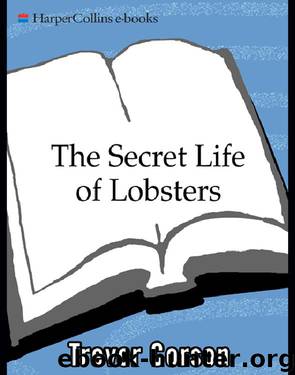The Secret Life of Lobsters by Trevor Corson

Author:Trevor Corson
Language: eng
Format: epub
Publisher: HarperCollins
Catching insects with a butterfly net hanging off a helicopter might have been easier. Lewis Incze, an oceanographer at the Bigelow Laboratory for Ocean Sciences, was an expert at catching the larvae of crustaceans, and he’d offered to use his remarkable skills to help Rick Wahle unravel the mystery of Damariscove Island. While Rick counted babies on the bottom, Lew searched for superlobsters on the surface.
Lew stole a glance at the sea ahead, then returned his gaze to the net skimming along the water from a boom off the side of the boat. The tiny holes in the net’s one-millimeter mesh barely let through water, let alone superlobsters, and Lew had to make sure a floating log or tangle of seaweed didn’t tear the net. A rectangular frame at the mouth of the net was attached to a pair of miniature water skis, which kept the lower edge of the opening at a depth of half a meter. If there were superlobsters swimming at the surface, Lew’s net ought to snag them.
The boat was running west in a line straight from Damariscove Island. At the end of the tow Lew hauled in the net and dumped out the contents into a sorting tray. A research assistant helped Lew comb through the pile of debris, seaweed, and plankton while the boat’s captain steered toward the beginning of the next tow. With the height of the superlobster season upon them—it was the middle of August—the researchers were repeating this routine sixty to seventy times a day.
Lew liked being on the water. He was an avid sailor, and his office at the Bigelow Laboratory in Boothbay Harbor was just a twenty-minute cruise from Damariscove Island. Lew had grown up in Maine and from the age of five had spent his summers living on a tiny island with a single cabin. His graduate work had taken him to the opposite edge of the continent, where he’d earned a Ph.D. chasing the larvae of Alaskan snow crabs through the Arctic climes of the Bering Sea. He was glad to be back in his old neighborhood, because the Gulf of Maine was a unique natural laboratory for the study of oceanography. Whether Lew was at work on a research cruise or enjoying a summer sail, the gulf’s constant movement intrigued him—its cold deep currents, its warm shallow eddies, its turbulent upwellings, its prevailing winds. The question of how the physics of the sea interacted with the biology of its creatures fascinated him.
After the last tow on the western side of Damariscove Island the captain gunned the boat for the mile-long trip around the island to the eastern side. The afternoon sun had kicked up a breeze out of the southwest, a trademark of the Maine coast in summer, and the boat wobbled on the fluttering sea. Lew had yet to analyze the numbers, but so far he’d seen an obvious pattern. On his offshore tows, Lew had been catching similar numbers of superlobsters whether he was on the east or west side of the island.
Download
This site does not store any files on its server. We only index and link to content provided by other sites. Please contact the content providers to delete copyright contents if any and email us, we'll remove relevant links or contents immediately.
The Lonely City by Olivia Laing(4564)
Animal Frequency by Melissa Alvarez(4147)
All Creatures Great and Small by James Herriot(3978)
Walking by Henry David Thoreau(3679)
Exit West by Mohsin Hamid(3631)
Origin Story: A Big History of Everything by David Christian(3470)
COSMOS by Carl Sagan(3344)
How to Read Water: Clues and Patterns from Puddles to the Sea (Natural Navigation) by Tristan Gooley(3235)
The Inner Life of Animals by Peter Wohlleben(3097)
How to Do Nothing by Jenny Odell(3097)
Hedgerow by John Wright(3093)
How to Read Nature by Tristan Gooley(3070)
Project Animal Farm: An Accidental Journey into the Secret World of Farming and the Truth About Our Food by Sonia Faruqi(3007)
Origin Story by David Christian(2988)
Water by Ian Miller(2950)
A Forest Journey by John Perlin(2902)
The Plant Messiah by Carlos Magdalena(2745)
A Wilder Time by William E. Glassley(2686)
Forests: A Very Short Introduction by Jaboury Ghazoul(2665)
